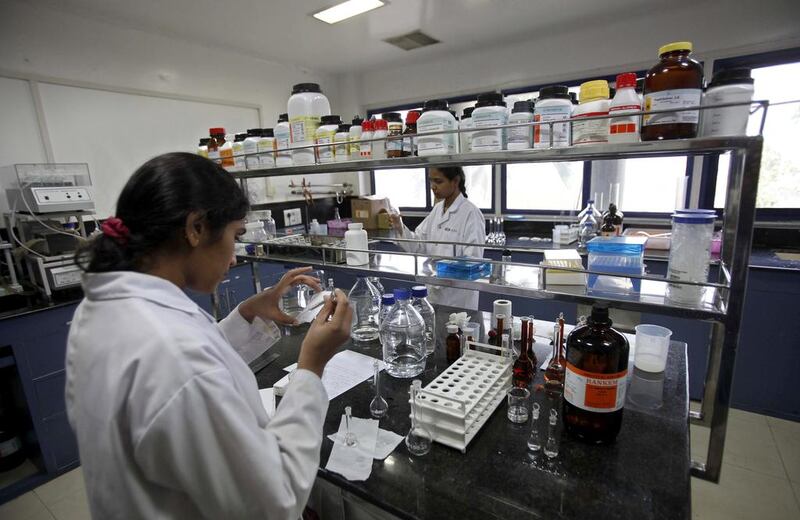India’s 720 billion rupee (Dh43bn) pharmaceutical sector urgently needs to raise its standards to avoid jeopardising its position as a leading global supplier of low-cost medicine, analysts say.
The issue has come to the forefront after the United States Food and Drug Administration (FDA) recently placed a ban on a second factory operated by the Indian drugs firm Wockhardt, citing concerns about data integrity.
The plant, located in the city of Aurangabad, was a major export facility for the firm. This followed the revelation in May that the Indian drugs firm Ranbaxy Laboratories had to pay a record fine of US$500 million for lying about its methods of testing medicine and manufacturing substandard drugs.
The US is the biggest market for both companies and India is the largest foreign source of medicine for the US.
The FDA in May issued a ban on Wockhardt’s plant in Waluj in the state of Maharashtra, expressing concerns about the discovery of unsanitary conditions near a manufacturing area and documentation violations.
In Britain, the country’s Medicines and Healthcare Products Regulatory Agency recalled 16 products made at the factory in July, and in October it withdrew its “good manufacturing practices” certificate for the Chikalthana facility.
“There is an urgent need for companies to tighten their quality protocols and exercise stricter good manufacturing practice compliance especially in areas of documentation and plant design,” said Utkarsh Palnitkar, the head of life sciences at professional services firm KPMG in India.
“Inability to meet regulatory standards eventually translates to erosion of millions from the topline,” he said. “However, more than the monetary considerations, the implications of these occurrences are a lot more serious when it comes to the impact on credibility of ‘Brand India’. India is the largest supplier of generic drugs to the US and some other developed economies.”
The Indian pharmaceutical industry was primarily driven by exports, Mr Palnitkar said, with India’s pharmaceutical exports reaching $14.7bn in the 2012 to 2013 financial year, a growth of 11 per cent from the previous year. Regulated western markets accounted for 55 per cent of that total, he said.
India’s pharmaceutical sector thrives on the production of cheap generic drugs, which are copies of off-patent medicines.
For years, India’s industry used its sophisticated reverse engineering skills to produce copies of patented western drugs. But in 2005 it started to follow patent protection laws to comply with the World Trade Organisation’s requirements.
Indian pharmaceutical companies are estimated to produce about one-fifth of generic drugs globally.
“While the need is more pronounced in case of export driven companies, there are numerous Indian manufacturing units which too need to shore up their quality standards,” said Mr Palnitkar. “The Indian regulatory set-up is complicated and under-equipped. With numerous entities involved, there is a clear need for distinct division in responsibility to ensure comprehensive and accurate monitoring.”
Such challenges in meeting standards set by the FDA are hampering the pharmaceutical sector’s growth.
The Indian pharmaceutical market is currently worth 720bn rupees, up from 657bn rupees last year, according to a recent report by PricewaterhouseCoopers (PwC) and the Confederation of Indian Industry. Although the market value has increased, the sector has experienced a slowdown in growth, which fell to 9.8 per cent this year, from 16.6 per cent last year, according to the report.
“The industry is also facing stricter regulations on manufacturing and quality practices in the domestic as well as the international markets,” the report stated. “Indian companies will have to raise their compliance to US FDA regulations as they drive their major share of exports from the US market.”
Other factors that are hurting the industry include a new drug pricing policy, along with delays in clinical trial approvals.
Sujay Shetty, PwC India’s leader of pharmaceuticals and life sciences, said India’s economic environment was now tougher than ever before.
“While pharmaceutical companies focus their attention on measures to combat the growth slowdown, they will need to work with the government and other stakeholders to discuss and resolve regulatory challenges,” he said.
Companies agree that there is work to be done to realise the industry’s potential.
Rajiv Modi, Cadila Pharmaceuticals’ chairman and managing director, said the industry had been efficient at producing affordable drugs for the world market.
“The sector is currently experiencing slow growth … the Indian and foreign companies operating in India will have to devise suitable strategies in order to be in the top 10 global markets by 2020,” he said.
Mr Palnitkar said the situation had become even more pressing because of the growing competition from China.
He said China “is the largest exporter of APIs [active pharmaceutical ingredients] globally and carries a similar value proposition as India in terms of low cost of manufacturing”.
“We believe that compliance as a culture should be engendered at the base level of Indian pharmaceutical companies, so that the entire landscape on build out emerges as one that is globally competent,” Mr Palnitkar said.
business@thenational.ae





